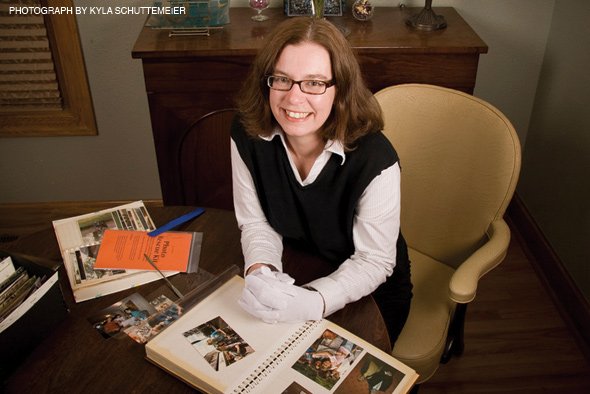Family Archivist Survival Kit Available for a Limited Time

Looking for archival boxes? Through the month of October Sally Jacobs, The Practical Archivist, is offering the Family Archivist Survival Kit to help family historians safely store photos, documents, and other family treasures. This is a once-a-year special package Sally created to help people get their “stuff” out of shoeboxes and into proper archival storage.
“Like a Time Machine. . . without digging & burying”
Sally is one of those generous genealogist who loves to talk about her favorite topic — archiving — and my go-to archivist when I need a consultation over a sticky preservation question. Her website is full of helpful tips and free advice, and the Family Archivist Survival Kit lives up to it’s name with storage boxes, supplies, and a CD with 10 hours of recorded instruction from Sally.
Read all about the Kit at The Practical Archivist and get your order placed before October 31, 2014. Kits ship in November and won’t be available again until next Fall.
Paper or Plastic?
I get a lot of questions here at The Family Curator and when I present lectures about the pros and cons of using big plastic tubs for archival storage. People really really seem to want to use them. They’re relatively inexpensive. They’re easy to find (hello, Target!). And they are waterproof. But it’s not a good idea. Ask Sally:
Much of preservation (and all of archival work, really) comes down to compromise and balance. Archivist like to joke that our motto is “it depends” because we work with variations that don’t allow simple universal rules. Plastic is a perfect example. Americans have always placed a great faith in the protectiveness of plastic, but it’s not always the best choice for long term storage. All together now: “It depends.”
The first rule is that any plastic you choose has to be neutral — it can’t be off-gassing anything that will affect what you place inside them. Vinyl is a big no-no. My favorite rule of thumb is that if it smells like a shower curtain, don’t put your photographs anywhere near it. Polypropylene is a popular plastic that is neutral, but your best bet is to find a product that has passed the Photographic Activity Test. The PAT is an accelerated aging test that tells the consumer it will not affect your photographs during storage.
The waterproof question is a bit tougher. Obviously, it’s a good idea to keep water away from paper, photographic prints, and film. But a cheap plastic tub is going to off-gass and add volatile chemicals to your storage environment…which will interact with your photographs in ways we can’t predict. Ideally, you want to store your family treasures in an archival paper box. The qualities of paper and the way it changes over time *can* be predicted. Paper also allows air to circulate and prevents items from “stewing in their own juices” as my preservation teacher would always say. Of course, a cardboard box is not waterproof, but in a scenario where there is risk of water, Archival Best Practice is to store your collection somewhere else.
But what about photos and documents?
Ask yourself: Do I really need to put this in plastic? If you’ve scanned your photos and share them digitally, I don’t think it’s necessary to store the original prints in an album or clear sleeves. They can go into archival paper envelopes and then into archival boxes. Clear plastic is the best choice for photos that you plan to pass around to many hands, since the oils and salts on fingers will transfer to the prints. A small historical society that serves up local history photographs to the public is a good example of this kind of heavy use.
Wouldn’t silica gel packets help if moisture gets inside a plastic tub?
Yes, but ideally you would store your treasures in something that wouldn’t collect moisture that way. I’ve been researching fireproof safes lately, and one of their main drawbacks is that the insulation needed to protect the contents from extreme heat will also create condensation inside the safe. How’s that for a trade off? (ugh) You can purchase metal canisters of desiccants that can be “recharged” by baking in an oven. Some even have a color indicator so you know when it’s time. I’m all for improving the bad storage areas you’re stuck with, but as always the best scenario is to keep your treasures somewhere where there isn’t a risk of water damage from either above or below.
Happily, the metal edge archival boxes in The Practical Archivist’s kits are strong, durable and provide excellent archival protection. Sally only sells the Family Archivist Survival Kit during the month of October, but she plans to offer a smaller De-Clutter Kit in Spring 2015. If you order one of her kits and need more supplies, she won’t leave you stranded and will help you reorder what you need.
I have to admit I’m a bit jealous of Sally’s profession. She gets to hang out in libraries and archives and work with all kinds of interesting material. I asked her how she became an Archivist (instead of an astronaut or iron chef) and I wish I had an illustration to go with her reply:
Ohmigosh, I love the idea of a wee little Sally J. drawing pictures of herself re-housing vintage photographs into archival folders…but that’s not how it happened. My “plan” was to become a photographer for Rolling Stone when I grew up. I don’t think anyone will be surprised to learn that this plan was a complete failure.
After I graduated college with a BA in History and Anthropology, all I knew was that I didn’t want to be a high school social studies teacher or a college professor*, so grad school in History was out. Instead, I got a great job working at a Half Price Books where I could figure out what the heck I was going to do when I grew up. One day, my coworker Allison announced she was going to library school. I had no idea there was such a thing! When I took a look at the catalog, I learned that they offered a specialization in “Archives Management” and those courses were taught by archivists working at the Wisconsin Historical Society. As soon as I read that, it all clicked.
Isn’t’ that the way it works? She didn’t want to be a teacher, but here she is teaching us all about archives! Thanks, Sally!
Feel free to leave Sally your archival questions here in the Comments, or drop her a note at The Practical Archivist and learn more about the Family Archivist Survival Kit.


